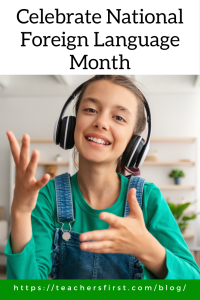Learning another language is not only learning different words for the same things, but learning another way to think about things.
Flora Lewis
March is National Foreign Language Month—a time to recognize the cognitive and cultural benefits of learning foreign languages. Studying languages builds communication skills and strengthens mental flexibility, critical thinking, and problem-solving across all subjects. National Foreign Language Month also presents opportunities to celebrate linguistic and cultural diversity worldwide, advocate for robust foreign language programs in our schools, and promote inclusive environments that embrace multilingual students in our classrooms.
Build cultural awareness, flexible thinking skills, and inclusiveness using technology and content that relates to students’ interests using some of these free technology tools:
Flip (reviewed here) – Use Flip to create topics for language and cultural discussions. One of Flip’s features is the inclusion of Immersive Reader (reviewed here). Immersive Reader provides many features, such as translation of text and video into many different languages, the ability to adjust the speed of audio, and options to highlight parts of speech. Listening to peers conversing in their native language enables students to grasp the language’s rhythm, understand cultural distinctions, and potentially acquire words or phrases for use in conversations with multilingual friends.
- Use Flip to create topics that engage students through discussions of their culture, such as this topic called Cultural Eats! This prompt uses food as a starting point and asks students to share a beloved dish native to their region or significant to their culture. Ask multilingual learners to share their favorite dish in their native language as their fellow students listen to the discussion. Use the Immersive Reader option to view the translation in English or a different language of their choice.
- Hi! I am…and I speak/understand…is another topic encouraging multilingual language learners to share and celebrate diversity in your school community. You might be surprised to learn how many languages your school members speak. In addition to students, include staff members when sharing this prompt to discover additional cultures represented in your school.
- Sign up for Global Celebrations and Connections projects shared within the Flip community and watch for new additions throughout the year.
Duolingo (reviewed here) – Personalize language learning using short activities and lessons that encourage users to think about information learned and apply that information to new lessons. Because Duolingo provides motivation and encouragement to language learners, students develop fluency and understanding quickly, then use their new skills to transfer learning and begin thinking in their newly acquired language.
Students love music, LyricsTraining (reviewed here), and Lyrics Gaps (reviewed here), use music videos to teach vocabulary and phrases using activities such as karaoke and filling in missing words. Many activities offer different levels, such as easy, medium, or hard. Using music to learn a language helps learners hear sounds in patterns different from those found when listening to spoken words, making it a wise choice for developing fluency and practicing learning a language in a natural way.
Another way to engage students through music while encouraging them to think in a foreign language is to share YouTube videos of popular songs in different languages. When students are already familiar with a tune and know most of the lyrics, it becomes easier to associate that understanding with the language they are learning. Use the YouTube videos in a couple of ways. First, this Taylor Swift video of Love Story includes text in Spanish while the song is sung in English. An alternative option is to share this video of the Love Story sung in Spanish.
Celebrating National Foreign Language Month is an excellent time to celebrate the diverse languages and cultures within our schools and communities. Online tools and communities provide motivation and encouragement, offering language learners opportunities to develop fluency quickly and begin thinking in their newly learned language. The capacity to alternate between languages enhances mental flexibility, improves memory, sharpens concentration, and fosters inclusiveness. These abilities aid in acquiring knowledge in all subject areas.
Do you have suggestions to promote thinking in a foreign language? We love to hear from our readers as we learn together.


